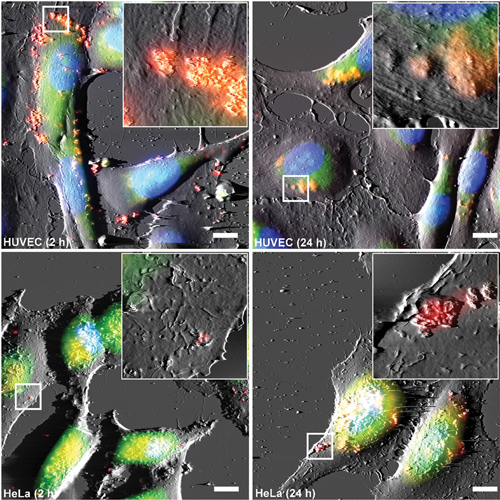Uptake Kinetics and Nanotoxicity of Silica Nanoparticles Are Cell Type Dependent
17-May-2013
In this study, it is shown that the cytotoxic response of cells as well as the uptake kinetics of nanoparticles (NPs) is cell type dependent. We use silica NPs with a diameter of 310 nm labeled with perylene dye and 304 nm unlabeled particles to evaluate cell type-dependent uptake and cytotoxicity on human vascular endothelial cells (HUVEC) and cancer cells derived from the cervix carcinoma (HeLa). Besides their size, the particles are characterized concerning homogeneity of the labeling and their zeta potential. The cellular uptake of the labeled NPs is quantified by imaging the cells via confocal microscopy in a time-dependent manner, with subsequent image analysis via a custom-made and freely available digital method, Particle_in_Cell-3D. We find that within the first 4 h of interaction, the uptake of silica NPs into the cytoplasm is up to 10 times more efficient in HUVEC than in HeLa cells. Interestingly, after 10 or 24 h of interaction, the number of intracellular particles for HeLa cells by far surpasses the one for HUVEC. Inhibitor studies show that these endothelial cells internalize 310 nm SiO2 NPs via the clathrin-dependent pathway. Remarkably, the differences in the amount of taken up NPs are not directly reflected by the metabolic activity and membrane integrity of the individual cell types. Interaction with NPs leads to a concentration-dependent decrease in mitochondrial activity and an increase in membrane leakage for HUVEC, whereas HeLa cells show only a reduced mitochondrial activity and no membrane leakage. In addition, silica NPs lead to HUVEC cell death while HeLa cells survive. These findings indicate that HUVEC are more sensitive than HeLa cells upon silica NP exposure.











